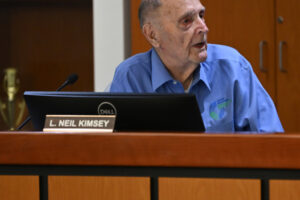The Camas City Council has unanimously approved an agreement that will guide development of 460 acres north of Lacamas Lake in the years to come. That development could include a variety of uses, from commercial and industrial to residential.
According to the comprehensive plan amendments, which were also approved on Sept. 3, the new zoning designations would include 314 acres for industrial business park development, 62.4 acres of multifamily high density and 38.1 acres of multifamily low density, 40 acres of single family medium density, and 5.62 acres of community commercial. Approximately 4 acres is set aside for open space that fronts Lacamas Lake.
During the public hearing on the development agreement, there were comments against and in favor of the proposal for the Lacamas Northshore properties, which are owned by approximately 11 different individuals and entities.
Kim Logan, representing the Mills family — owners of the second largest parcel within the Lacamas Northshore — said the development agreement puts into place a vision that started years ago.
“A cluster of jobs and housing is what was always envisioned here and pedestrian friendly infrastructure,” he said. “If you look at the overall plan, it very much is a mixed use of housing, jobs and schools and community. It’s exactly the type of development that we had hoped for.”




